When is YAG Peripheral Iridotomy Needed?
&srotate=0)
In addition to various types of tissues and membranes, your eyes rely on different fluids. Tears are a well-known fluid, which protects and lubricates the exterior of the eyes. Yet the inside of the eye is also swirling with an aqueous ocular fluid. It flows between the lens, which focuses incoming light, and the iris, the colored part of the eye. If the flow of fluid is interrupted or hampered, it could lead to issues, such as acute angle-closure glaucoma or narrow-angle closure glaucoma.
If left untreated, glaucoma causes vision loss. Fortunately, our board-certified ophthalmologists at Rothchild Eye Institute are here for you. If you live near Boca Raton, Boynton Beach, or Palm Beach County, contact us today to find out how we can help you.
Why is glaucoma such a serious threat?
Glaucoma is "the silent thief of sight" because it does its damage sneakily. Glaucoma isn't a single disorder but a group of eye diseases that cause damage to the optic nerve, a vital structure that transmits signals from the eyes to the brain. As such, its proper functioning is critical for proper vision and eye health. This "silent thief" affects 60 million people globally and is one of the world's leading causes of blindness.
Glaucoma's most dangerous feature is its imperceptibility. It advances slowly, causing damage within the eye without apparent signs or symptoms. This pressure-derived damage may cause irreversible harm before it's detected, making it a severe threat for millions of Americans. It also showcases the importance of scheduling regular eye exams with our experts at Rothchild Eye Institute, so we can diagnose glaucoma and help prevent its progression as much as possible.
In rare cases, the pressure may build up quickly and can cause acute angle-closure glaucoma, which may cause rapid, irrevocable damage and is considered a medical emergency. Therefore, it's vital to know the warning signs and act right away. These symptoms include the following:
-
Pain in the eyes or headache
-
Visual disturbances, including blurred vision or halos around light sources
-
Redness of the eye
-
Nausea and vomiting
When is a YAG Peripheral Iridotomy necessary?
As we mentioned earlier, an aqueous ocular fluid is constantly in flux between the lens and the iris. The fluid passes through and is filtered by another essential structure, the trabecular network. This meshwork resides at the "angle of the eye," or the juncture where the cornea and the iris meet. Obstructions here can have serious detrimental effects, as blockages lead to an increase in pressure.
One effective treatment is YAG peripheral iridotomy (PI). Here's how it works: we first apply numbing eye drops for your comfort. We may also place a lens over the eye to improve laser precision. The YAG laser is named for the crystals it uses to produce its energy (Yttrium, Aluminum, Garnet) and can safely and quickly create a tiny incision on the edge of the iris. This opens up a working drainage channel that allows the fluid to flow freely once more. The resultant reduction in pressure prevents intraocular damage and effectively manages glaucoma.
Find relief and protect your sight
Don't let the silent thief of sight rob you of your vision. You can find relief and efficient glaucoma management strategies at Rothchild Eye Institute, where our ocular experts devote themselves to helping you enjoy an optimal visual outcome.
One such solution, YAG laser PI, is a quick outpatient procedure that only takes a few minutes per eye. After-effects are light and quickly dissipate, which is a small price for effective, lasting glaucoma management. Protect your sight and eye health by reaching out today or visiting us in Delray Beach, FL.